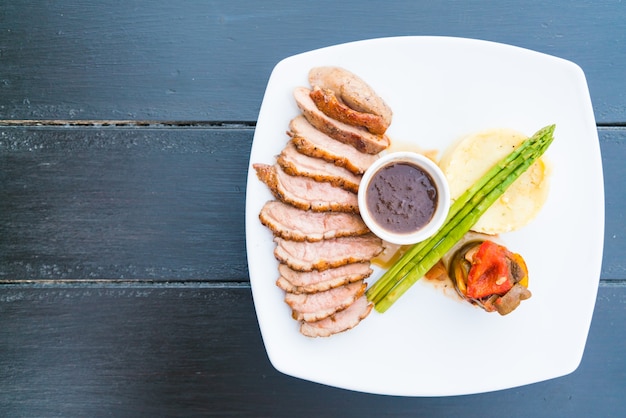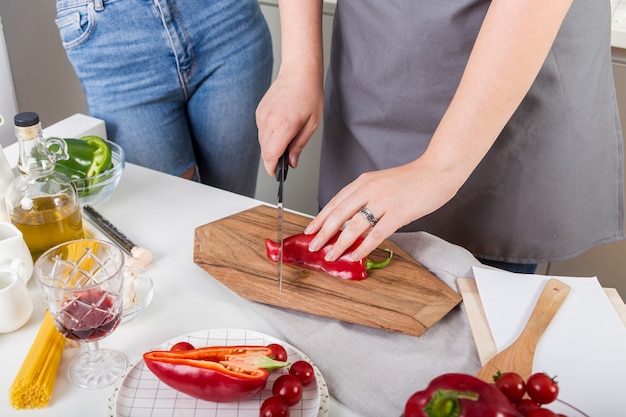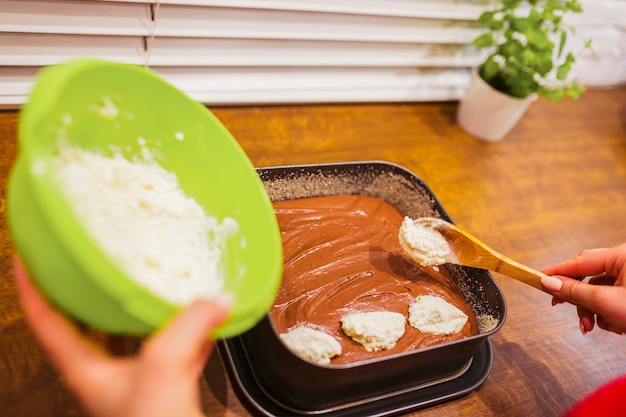Let's be honest, we've all been there. You pick out those gorgeous, thin pork chops, picturing a delicious, juicy dinner. But then, reality sets in. The chops end up dry and tough, leaving you with a disappointing meal. As a seasoned cook, I've had my fair share of pork chop disasters, but I've also learned some valuable tricks to guarantee perfectly tender and juicy results.
In this article, I'll be sharing my insider knowledge, drawing upon years of experience and countless kitchen experiments, to guide you through the art of cooking thin pork chops. We'll explore the crucial steps, from selecting the right cut to mastering the perfect cooking technique. Get ready to impress your friends and family with juicy, flavorful pork chops that will have them asking for seconds!
(Part 1) The Pork Chop Chronicles: A culinary journey

My passion for cooking has always been driven by a desire to create delicious, satisfying meals for those I love. But let's be honest, I haven't always been a culinary master. My early attempts at cooking pork chops were, shall we say, less than stellar. I vividly recall one particular incident where the chops emerged from the oven as dry and brittle as a forgotten biscuit. That was the day I realized I needed to take my pork chop game to a whole new level.
So, I embarked on a quest to master the art of juicy pork chop cooking. I devoured cookbooks, browsed countless websites, and even experimented with different cooking methods, from pan-frying to roasting. Along the way, I discovered a wealth of valuable tips and tricks, which I'm eager to share with you.
(Part 2) The Science Behind juicy pork chops

Before we dive into the practical tips, it's helpful to understand the science behind juicy pork chops. Pork chops are lean cuts of meat, meaning they have a lower fat content compared to other cuts like ribs or belly. This lower fat content can make them prone to drying out during cooking.
However, there are several factors that can contribute to dry pork chops:
2.1 The Impact of Heat:
Think of it like this: high heat is like a bully in the kitchen. It forces the proteins in the meat to contract rapidly, squeezing out precious moisture. This is why it's essential to cook thin pork chops over medium heat, allowing them to cook more evenly and retain their juiciness. The slower, gentler heat allows the meat to relax and cook through without becoming tough and dry.
2.2 The Importance of Temperature:
Overcooking pork chops is like pushing your luck. Once the meat reaches its ideal internal temperature, it's crucial to remove it from the heat source to prevent further cooking and drying. This ensures that the meat stays tender and juicy, rather than becoming overcooked and dry.
2.3 The Role of Fat:
While pork chops are lean, they do contain some fat. This fat is essential for flavour and moisture. Think of it as a natural built-in moisturizer. When cooking, the fat renders, creating a delicious, flavorful sauce. Therefore, it's important to select cuts with a thin layer of fat. Don't be afraid to leave the fat on the chop; it will help keep it moist during cooking. You're essentially harnessing the power of natural fat to lock in moisture and enhance flavor.
(Part 3) The Secret to Selecting the perfect pork chop

The journey to perfect pork chops starts with choosing the right ingredients. Here's how to select the perfect pork chops for your culinary masterpiece:
3.1 The Anatomy of a Good Pork Chop:
When selecting pork chops, look for ones that are uniformly thick. Thin pork chops are more prone to drying out during cooking, as they cook faster and can easily overcook. If possible, choose cuts that have a thin layer of fat surrounding the meat. The fat will render during cooking, adding flavour and juiciness. You're looking for a balance of lean meat and a bit of fat to ensure a flavorful and tender chop.
3.2 Looking for Quality:
Always look for pork chops that have a light pink colour, with a slightly marbled appearance. This marbling is a sign of good fat distribution, which will contribute to a juicier chop. Avoid any chops that are discoloured or have an off-putting odour. Fresh pork chops should feel firm to the touch, with a smooth texture. You want your pork chops to be fresh and inviting, not discolored or showing signs of spoilage.
3.3 The Butcher's Wisdom:
If you're unsure about selecting the right pork chops, don't hesitate to ask your butcher for advice. They're experts in identifying quality meat and can guide you towards the best cuts for your desired cooking method. They can also provide valuable tips on how to prepare and cook your chosen cuts for optimal results.
(Part 4) The Art of Prepping: Preparing for Perfection
Once you've selected the perfect pork chops, it's time to prep them for a culinary masterpiece. Proper preparation is crucial for achieving juicy, tender results:
4.1 Bringing the Pork to Room Temperature:
Allowing your pork chops to come to room temperature before cooking helps them cook more evenly. This is because cold meat will require longer cooking times, which can lead to dryness. Remove the chops from the refrigerator 30 minutes before cooking. Think of it like giving the meat a chance to relax and adjust to the cooking environment, making for a more even cooking experience.
4.2 The Magic of Brining:
Brining is a simple technique that involves soaking the pork chops in a salt solution, typically for 30 minutes to an hour. The salt draws moisture from the meat, allowing it to absorb more moisture during cooking. Brining is a great way to enhance the tenderness and juiciness of lean cuts like pork chops. It's like giving the meat a hydration boost, resulting in a more flavorful and tender dish.
To brine, simply mix a cup of salt with 4 cups of water and submerge the pork chops in the solution for the specified time. The salt draws out some of the meat's natural moisture, but it also allows the meat to absorb more moisture as it cooks, resulting in a juicier and more flavorful chop.
4.3 Seasoning with Savour:
Seasoning is a crucial step in creating flavourful pork chops. Use a combination of salt and pepper, and feel free to experiment with other spices like garlic powder, paprika, or rosemary. Remember to season both sides of the chop evenly for a consistent flavour profile. This ensures that every bite of the pork chop is bursting with delicious flavor. Don't be shy with your seasonings, as they will enhance the natural flavors of the meat.
(Part 5) The Dance of Heat: Mastering the Cooking Technique
Now comes the crucial part – the cooking process itself. Here are some expert tips to ensure your thin pork chops stay juicy and delicious:
5.1 The Power of Medium Heat:
High heat can cause the proteins in pork chops to contract rapidly, squeezing out moisture. Instead, cook over medium heat, allowing the chops to cook more evenly and retain their juiciness. Use a cast iron pan or a non-stick skillet. The key is to find that sweet spot where the heat is enough to cook the meat properly but not so intense that it dries out. Think of it as a slow and steady dance with the heat.
5.2 Sear It Like a Pro:
Searing is a technique that involves cooking the pork chops over high heat for a short period, creating a crispy, flavorful crust. Sear both sides of the chop for about 2 minutes each, until golden brown and caramelized. This searing process helps lock in the moisture and creates a delicious crust. It's like giving the pork chop a protective layer, preventing moisture loss during cooking.
To sear, heat your pan over high heat and add a small amount of oil. When the oil shimmers, carefully place the pork chops in the pan. Make sure to sear each side for about 2 minutes, or until it develops a nice golden brown crust. This crust will add a delicious flavor and texture to your pork chops.
5.3 Finishing Touches:
Once the pork chops are seared, reduce the heat to medium-low and continue cooking until they reach an internal temperature of 145°F (63°C). This can take anywhere from 4-6 minutes per side, depending on the thickness of the chops. You can use a meat thermometer to check the internal temperature. The goal is to cook the meat through without overcooking it, resulting in a tender and juicy chop.
To ensure you don't overcook the pork chops, use a meat thermometer to check the internal temperature. Insert the thermometer into the thickest part of the chop and make sure it reads 145°F (63°C). If you are using a digital thermometer, make sure to calibrate it before each use to ensure accurate readings.
5.4 Resting for Perfection:
Once the pork chops are cooked, let them rest for 5-10 minutes before slicing and serving. This allows the juices to redistribute throughout the meat, resulting in even more tender and juicy chops. Think of it as letting the meat relax and reabsorb those flavorful juices, making for a more succulent bite. Cover the chops loosely with foil to keep them warm and moist during this resting period.
(Part 6) The Delectable World of Garnishes and Sauces
While juicy pork chops are delicious on their own, garnishes and sauces can elevate them to a whole new level of culinary brilliance.
6.1 The Art of Garnishing:
Simple garnishes can add a touch of elegance and flavour to your pork chops. Consider serving them with a sprinkle of fresh herbs like parsley or thyme, a squeeze of lemon juice, or a few slices of cherry tomatoes. These simple additions can add a pop of color and freshness to your dish, enhancing both the visual appeal and the flavor.
6.2 The Sauce Magic:
Pork chops pair wonderfully with a variety of sauces. Here are some ideas:
- Apple Cider Sauce: A sweet and tangy sauce made with apple cider, brown sugar, and a hint of cinnamon. It complements the flavour of pork beautifully. The sweetness of the apple cider and brown sugar balances the savory flavors of the pork, while the cinnamon adds a warm and comforting note.
- Mushroom Sauce: A rich and earthy sauce made with sautéed mushrooms, cream, and a touch of white wine. It's a classic pairing for pork chops. The earthy flavors of the mushrooms and the richness of the cream create a luxurious and satisfying sauce that complements the pork perfectly.
- Rosemary-Lemon Sauce: A fragrant and bright sauce made with fresh rosemary, lemon juice, and olive oil. It adds a refreshing touch to pork chops. The earthy aroma of rosemary and the zesty tang of lemon juice create a vibrant and aromatic sauce that adds a delightful complexity to the dish.
(Part 7) cooking techniques for the Savvy Chef
While pan-frying is a classic method for cooking pork chops, you can explore other techniques to add variety to your culinary repertoire.
7.1 The Roasting Revolution:
roasting pork chops in the oven is a simple and effective way to achieve juicy, tender results. Preheat your oven to 375°F (190°C). Place the seasoned pork chops on a baking sheet and roast for 15-20 minutes, or until they reach an internal temperature of 145°F (63°C). During the last few minutes of cooking, baste the chops with a flavorful glaze for an added touch of sweetness. Roasting allows the meat to cook slowly and evenly, resulting in a tender and juicy chop. The glaze adds a layer of sweetness and flavor that enhances the taste of the pork.
7.2 The Grill Master's Delight:
grilling pork chops over medium heat is another excellent way to achieve a crispy crust and juicy interior. Before grilling, preheat your grill and lightly oil the grate to prevent sticking. Place the seasoned pork chops on the grill and cook for 5-7 minutes per side, or until they reach an internal temperature of 145°F (63°C). Grilling imparts a smoky flavor to the pork chop, while the heat creates a crispy crust on the outside while keeping the inside moist and tender.
(Part 8) Pork Chop Variations for culinary adventure
Don't be afraid to experiment with different flavour combinations and cooking techniques. Here are a few ideas for pork chop variations:
8.1 Pork Chop with Asian Flair:
Marinate thin pork chops in a mixture of soy sauce, ginger, garlic, and sesame oil for at least 30 minutes. Then, pan-fry them over medium heat until cooked through. Serve them with a side of rice and stir-fried vegetables for a delightful Asian-inspired meal. The combination of soy sauce, ginger, garlic, and sesame oil creates a savory and aromatic marinade that adds a distinct Asian flavor to the pork chops.
8.2 Mediterranean Pork Chop Delight:
Season thin pork chops with a blend of Mediterranean spices like oregano, thyme, rosemary, and garlic powder. Then, pan-fry them over medium heat until cooked through. Serve them with a side of roasted vegetables and a lemon-herb sauce for a delicious and flavourful Mediterranean dish. The aromatic blend of Mediterranean spices adds a unique depth of flavor to the pork chops, while the roasted vegetables and lemon-herb sauce complement the flavors beautifully.
8.3 Sweet and Savoury Pork Chop Sensation:
Brush thin pork chops with a mixture of honey, Dijon mustard, and soy sauce. Then, pan-fry them over medium heat until cooked through. The sweet and savoury flavour combination is a delightful twist on the classic pork chop recipe. The honey adds a touch of sweetness, the Dijon mustard provides a tangy kick, and the soy sauce adds a savory umami note, creating a delicious flavor profile.
(Part 9) FAQs: Solving the Pork Chop Puzzle
Here are some common questions about cooking juicy thin pork chops, along with expert answers to help you achieve culinary perfection:
| Question | Answer |
|---|---|
| What is the best way to prevent pork chops from drying out? | There are several ways to prevent pork chops from drying out. Use medium heat when cooking, avoid overcooking, and consider brining the chops before cooking. You can also use a marinade or glaze to add moisture and flavor. Remember, the goal is to cook the pork chop slowly and evenly, without overcooking it. |
| How long should I cook thin pork chops? | The cooking time for thin pork chops will vary depending on the thickness of the chops and the cooking method used. As a general guideline, pan-frying thin pork chops should take about 4-6 minutes per side. For roasting, cooking time will be around 15-20 minutes. Always use a meat thermometer to ensure the chops reach an internal temperature of 145°F (63°C). |
| Can I cook pork chops on high heat? | While high heat is good for searing pork chops initially, it's best to reduce the heat to medium for the remaining cooking time. High heat can cause the chops to dry out and become tough. |
| What are the signs of overcooked pork chops? | Overcooked pork chops will be dry, tough, and have a grayish-brown colour. They may also have a slightly rubbery texture. It's important to pay attention to the appearance of the pork chop as it cooks, as this will provide clues about its doneness. |
| What can I do with leftover pork chops? | Leftover pork chops can be used in a variety of dishes, such as salads, sandwiches, or soups. You can also slice them and add them to pasta dishes or stir-fries. Make sure to store them properly in the refrigerator for up to 4 days. |
I hope this comprehensive guide has equipped you with the knowledge and confidence to create juicy, tender pork chops that will impress your taste buds and delight your loved ones. Remember to embrace the journey, experiment with different flavours and cooking techniques, and most importantly, have fun in the kitchen! Bon appétit!
Everyone is watching

Prime Rib Roast Cooking Time Chart: Per Pound Guide
Cooking TipsPrime rib roast. Just the name conjures images of lavish dinners, crackling fires, and hearty laughter. It’s ...

How Long to Bake Potatoes in the Oven (Perfect Every Time)
Cooking TipsBaked potatoes are a staple in my kitchen. They're incredibly versatile, delicious, and surprisingly easy to m...

Perfect Rice Every Time: The Ultimate Guide to Cooking Rice
Cooking TipsAs a self-proclaimed foodie, I've always been a bit obsessed with rice. It's the foundation of countless cuisi...

The Ultimate Guide to Cooking Asparagus: Tips, Techniques, and Recipes
Cooking TipsAsparagus. The mere mention of this spring delicacy conjures up images of vibrant green spears, crisp and burs...

Ultimate Guide to Cooking the Perfect Thanksgiving Turkey
Cooking TipsThanksgiving. Just the word conjures up images of overflowing tables laden with delicious food, the scent of r...
